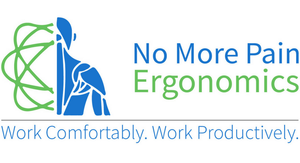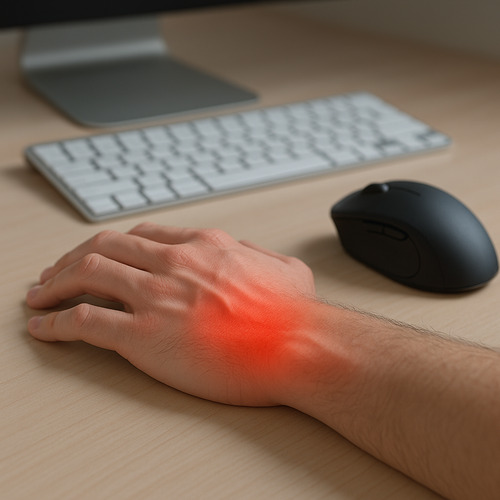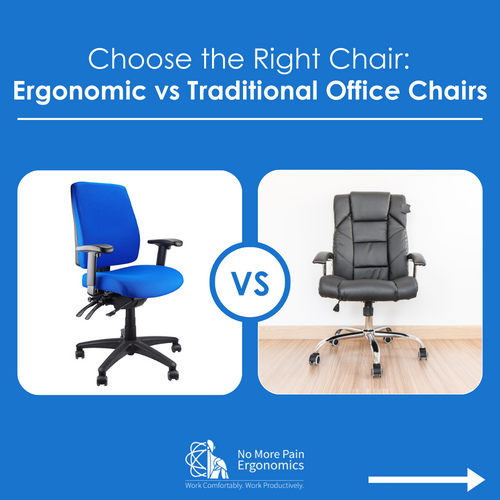In our experience, back pain is the single most common reason our customers come to us for help. It's a pain that can varying in sensation (burning, aching, sharp shooting, tingling) and can cause serious damage if left untreated long term. We've put our heads together to come up with the top 5 reasons you're getting back pain at your desk and some simple solutions to help your back pain.
1) You're Sitting with Poor Posture
It's easy for most people to rack up anywhere between 6 - 12 hours of sitting at their desk each day. This prolonged period of sitting is obviously going to play a significant role in the cause of back pain. There are certain muscles in our body that play an important role in maintaining our posture. However, overtime these postural muscles can become fatigued and slowly begin to "switch off". The consequence of this is that our posture is altered - our neck starts to protrude forward, our shoulders roll forward and our spine starts to slump forward changing its natural curvature. All of these changes contribute to additional stress or "pulling" on muscles and other tissues (ligaments/tendons) such as our lower back muscles. Over time, this additional stress can lead to the onset of aches and pains.

Solution
In an ideal world, try not to sit for anymore then 2 hours continuously. This means getting up and moving around. Try to incorporate more movement into your day and less sitting at your desk. Additionally, stretching every 2 hours is another great way to reduce the "pulling" on muscles and to help increase blood flow them.
2) You're Sitting for too Long
Sitting has been labelled as the new smoking. There is a significant level of evidence to suggest that prolonged Sitting is a hazardous behavior for our health. Research has found links between the amount of time people spent sitting and their risk of chronic conditions such as lower back pain, diabetes, high blood pressure and high cholesterol.

Solution
Try to incorporate more movement into your day and less sitting at your desk. The addition of a small bout (2-5 minutes) of walking every 2-4 hours can help to reduce the amount of damage that is caused by sitting. If your budget permits, consider investing in a standing desk. Standing is a great way to burn more calories, reduce your risk of chronic conditions and best of all, improve your productivity.
3) Your Workstation is Setup Wrong
Did you know the location of your keyboard and mouse could be the direct cause of your lower back pain? Inappropriate positioning of your keyboard and mouse can cause you to have to reach forward to access them. Overtime, your body will naturally want to move closer towards your keyboard and mouse to reach the degree of reaching. This can lead to your body leaning forward and your back coming off the back of your chair. This posture increases the activity of the muscles in your lower back, meaning they have to work more to support your posture. Overtime, these muscles will fatigue and lead to the development of aches and pains in your lower back.

Solution
Move your keyboard and mouse to a position that allows you to easily reach them from your chair. Your elbows should be beside your body but your keyboard and mouse should still be within reach. Keep your back supported by keeping it against the back of your chair. If your desk space is too small or awkward to accommodate your keyboard and mouse within easy reach, you may want to install an underdesk or overdesk keyboard drawer.
4) You're Twisting Too Much
Think about where your desk is located and think about where your colleagues are located - do they sit next to you or do they enter in through your door from the side? If you are frequently twisting to turn around and see a colleague this may be the cause of your back pain.

Solution
Office chairs have a swivel feature just for this reason - to prevent twisting. Turn your whole body by turning your chair. It really is that simple.
5) Your Chair lacks Lumbar Support
A good ergonomic chair will provide you with multiple adjustments and ultimately a comfortable experience. Many cheap or out dated office chairs lack adjustments, in particular an adjustable lumbar support. Your lower spine has a curve in it and this curve needs support in order to maintain the posture. If your chair lacks an adjustable lumbar support you could be sitting with next to no lumbar support or worse the lumbar support placing pressure too high or too low to where it is actually required.

Solution
Try adjusting your backrest to position the lumbar support in the right position - the curve of your lower back. If you still don't get relief, you may want to investigate the addition of a lumbar support cushion or a new ergonomic chair with a lumbar support.
















← Older Post Newer Post →
0 comments
Get in Touch
Still have a question or simply want to discuss what ergonomic products are best suited? Get in touch, our expert team is available to provide free advice and support.